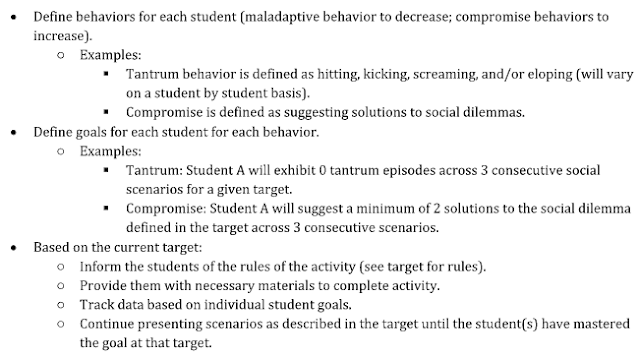We’ve talked before about why individualizing goals for the kids in your group is important, but what exactly does it mean to set a goal? Every goal should have a sheet with the current target, the purpose of the program, the procedures of implementing the program, how to collect data on the target, and what constitutes as mastery. Here’s a basic rundown of the elements that go into setting goals for autism spectrum kids in a social skills play group:
Purpose
n Why are you setting this particular goal? Which behaviors
are you looking to increase or decrease? When setting goals, think about
whether or not those goals will improve the individual’s life. If the answer is
no, it’s not a good goal to set. We’re always looking for social validity, so
for example: your 5 year old student keeps making jokes about poop. You think
poop jokes are gross, but you wouldn’t necessarily want to write a program to
decrease the jokes, because that’s typical behavior for a 5 year old, and other
typical students are also making similar jokes. We’re not looking for
cookie-cutter perfect kids, we’re helping kids interact with other kids in
socially acceptable ways. Knowing which skills your kids are working on and why
they’re working on them is important for understanding how best to implement
the program’s procedures. Often times the social skills group goals set for
your kids will be related to goals set for one-on-one therapy sessions. For
instance, let’s say a student’s home therapist is working on increasing wh-
questions. The same program may be tweaked to fit social group by asking peers
to ask the student wh- during group to track generalization.
Procedures for Implementation
n What steps go into this goal? For instance, if you’re
working on a tacting program (labelling objects and people based on visual cues)
using picture cards, your procedure might look like this:
i. Take out picture card
ii. Hold up picture card of preferred item
iii. If child responds appropriately, put a correct trial mark
in trial box. If child responds inappropriately or does not respond, give
correct answer and return to step two.
That’s just one example, and procedures can
(and almost always will) have many more steps than that. Knowing your procedure
is important because following the same procedure across different environments
and therapists, teachers, parents, and caregivers is the only way to get
reliable and accurate data across the board. This is especially important to
note when individualizing goals for social group, as we’ve discussed here.
Here’s what an example procedure might look like:
As you can see, it’s specific and doesn’t leave
room for too much interpretation, which is important. Everyone implementing the
program should be able to quickly read and understand the procedures to keep
them consistent.
Collecting Data
n There’s an entire post on collecting data during social
group here, but the basics of it are as follows. You’ll most likely have a few
group-appropriate goals to focus on with a description of their procedures, and
then a row of small square boxes in which to mark whether the target behavior
was completed or not, with each box representing one trial. If a correct trial occurred,
you would record a +. If a prompted trial occurred, you would mark a P. This is
called trial-by-trial data collection, and it’s what’s most often used during
social skills groups with anecdotal data (general notes) kept as well. Keeping
accurate, consistent data is important for several reasons, but above all data
will tell you when a target has been mastered so you can move on to the next
target.
Mastery criteria
n The idea behind mastery criteria is to set a level of
performance that lets the instructor know the student is ready for the
difficult of the target to increase. Mastery should be a certain percentage
above the child’s current performance. Mastery criteria are set somewhere
between 80% and 100% correct performance across multiple sessions or days. The
high level of accuracy is included because the skill must be established before
moving on to the next target. Including a time component or multiple session
component to the mastery ensures that phenomenal performance on a given day is
not a fluke.
Targets
n Finally we have targets, which are different levels of
program mastery. Many programs will have similar procedures for several
targets. For example, let’s say that Barry’s target is 1 peer response
(responding when a friend asks a question or says hello) with one prompt, with
the program purpose being increased intraverbals. Once he’s mastered that
target, his next target in this program might be 1 peer response with no
prompts. Targets build off of each other to increase or decrease the target
behavior. In the ABA world this is known as shaping, which we’ll talk about
more in a later blog. All of these elements put together form a solid program
that can be used to make social group a better, more efficient process!


No comments:
Post a Comment